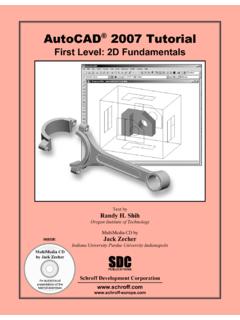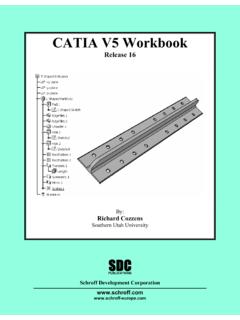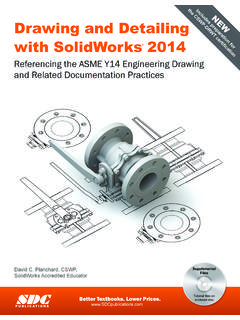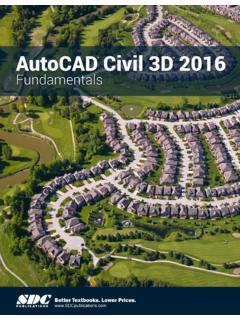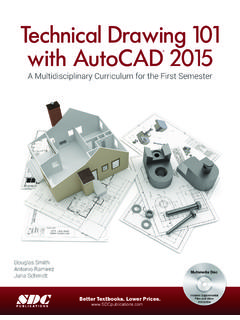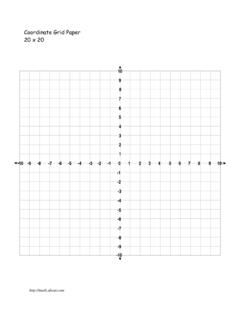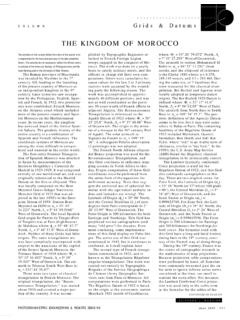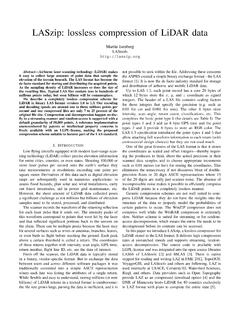Transcription of AutoCAD 2013 ® ™ Tutorial - First Level
1 Multimedia DVDV ideo presentations of selected tutorialsand exercisesPrepares you for the Autodesk Certified Associate ExamAutoCAD 2013 Tutorial - First Level : 2D FundamentalsRandy H. Shih SDCPUBLICATIONS Textbooks. Lower Development CorporationVisit the following websites to learn more about this book: AutoCAD 2013 Tutorial : 2D Fundamentals 1-1 Chapter 1 AutoCAD Fundamentals Create and Save AutoCAD drawing files Use the AutoCAD visual reference commands Draw, using the LINE and CIRCLE commands Use the ERASE command Define Positions using the Basic Entry methods Use the AutoCAD Pan Realtime option 1-2 AutoCAD 2013 Tutorial : 2D Fundamentals AutoCAD Certified Associate Examination Objectives Coverage This table shows the pages on which the objectives of the Certified Associate Examination are covered in Chapter 1. Section 1: Controlling the Display in Drawings Zoom Drawing LIMITS.
2 1-5 Status Bar ..1-10 GRID Display ..1-10, 1-11 PAN Realtime ..1-20 Section 2: Creating Basic Drawings Format ..1-5 Units Setup ..1-5 LINE Coordinates ..1-8 Interactive Input method ..1-9 SNAP Option ..1-10 World space ..1-15 User coordinate system ..1-15 World coordinate system ..1-15 UCS icon Display ..1-16 TTR, circle ..1-16 Relative Coordinate ..1-17 Coordinate systems ..1-17 Cartesian coordinate system ..1-17 Absolute , 1-18 Positions, LINE, Close option ..1-19 CIRCLE TTT, circle ..1-23 ARC command .. 1-33 Section 3: Manipulating Objects ERASE command ..1-13 Selection Certified Associate Reference Guide AutoCAD Fundamentals 1-3 Introduction Learning to use a CAD system is similar to learning a new language. It is necessary to begin with the basic alphabet and learn how to use it correctly and effectively through practice. This will require learning some new concepts and skills as well as learning a different vocabulary.
3 Today, the majority of the Mechanical CAD systems are capable of creating three-dimensional solid models. Nonetheless, all CAD systems create designs using basic geometric entities and many of the constructions used in technical designs are based upon two-dimensional planar geometry. The method and number of operations that are required to accomplish the basic planar constructions are different from one system to another. In order to become effective and efficient in using a CAD system, we must learn to create geometric entities quickly and accurately. In learning to use a CAD system, lines and circles are the First two, and perhaps the most important two, geometric entities that one should master the skills of creating and modifying. Straight lines and circles are used in almost all technical designs. In examining the different types of planar geometric entities, the importance of lines and circles becomes obvious. Triangles and polygons are planar figures bounded by straight lines.
4 Ellipses and splines can be constructed by connecting arcs with different radii. As one gains some experience in creating lines and circles, similar procedures can be applied to create other geometric entities. In this chapter, the different ways of creating lines and circles in AutoCAD 2013 are examined. Starting Up AutoCAD 2013 1. Select the AutoCAD 2013 option on the Program menu or select the AutoCAD 2013 icon on the Desktop. Once the program is loaded into memory, the AutoCAD 2013 drawing screen will appear on the screen. 1-4 AutoCAD 2013 Tutorial : 2D Fundamentals Note that AutoCAD automatically assigns generic name, Drawing X, as new drawings are created. In our example, AutoCAD opened the graphics window using the default system units and assigned the drawing name Drawing1. 2. If necessary, click on the down-arrow in the Quick Access bar and select Show Menu to display the AutoCAD Menu Bar. The Menu Bar provides access to all AutoCAD commands.
5 AutoCAD Menu Bar AutoCAD Fundamentals 1-5 Drawing Units Setup Every object we construct in a CAD system is measured in units. We should determine the system of units within the CAD system before creating the First geometric entities. 1. In the Menu Bar select: [Format] [Units] The AutoCAD Menu Bar contains multiple pull-down menus, where all of the AutoCAD commands can be accessed. Note that many of the menu items listed in the pull-down menus can also be accessed through the Quick Access toolbar and/or Ribbon panels. 2. Click on the Length Type option to display the different types of length units available. Confirm the Length Type is set to Decimal. 3. On your own, examine the other settings that are available. 4. In the Drawing Units dialog box, set the Length Type to Decimal. This will set the measurement to the default English units, inches.
6 1-6 AutoCAD 2013 Tutorial : 2D Fundamentals 5. Set the Precision to two digits after the decimal point as shown in the above figure. 6. Pick OK to exit the Drawing Units dialog box. Drawing Area Setup Next, we will set up the Drawing Limits by entering a command in the command prompt area. Setting the Drawing Limits controls the extents of the display of the grid. It also serves as a visual reference that marks the working area. It can also be used to prevent construction outside the grid limits and as a plot option that defines an area to be plotted/printed. Note that this setting does not limit the region for geometry construction. 1. In the Menu Bar select: [Format] [Drawing Limits] 2. In the command prompt area, the message Reset Model Space Limits: Specify lower left corner or [On/Off] < , >: is displayed. Press the ENTER key once to accept the default coordinates < , >. 3. In the command prompt area, the message Specify upper right corner < , >: is displayed.
7 Press the ENTER key again to accept the default coordinates < , >. AutoCAD Fundamentals 1-7 4. On your own, move the graphic cursor near the upper-right comer inside the drawing area and note that the drawing area is unchanged. (The Drawing Limits command is used to set the drawing area, but the display will not be adjusted until a display command is used.) 5. Inside the Menu Bar area select: [View] [Zoom] [All] The Zoom All command will adjust the display so that all objects in the drawing are displayed to be as large as possible. If no objects are constructed, the Drawing Limits are used to adjust the current viewport. 6. Move the graphic cursor near the upper-right comer inside the drawing area and note that the display area is updated. 7. Hit the function key [F7] once to turn off the display of the Grid lines. Note that function key [F7] is a quick key which can be used to quickly toggle on/off the grid display.
8 1-8 AutoCAD 2013 Tutorial : 2D Fundamentals Drawing lines with the LINE command 1. Move the graphics cursor to the First icon in the Draw panel. This icon is the Line icon. Note that a brief description of the Line command appears next to the cursor. 2. Select the icon by clicking once with the left-mouse-button, which will activate the Line command. 3. In the command prompt area, near the bottom of the AutoCAD drawing screen, the message _line Specify First point: is displayed. AutoCAD expects us to identify the starting location of a straight line. Move the graphics cursor inside the graphics window and watch the display of the coordinates of the graphics cursor at the bottom of the AutoCAD drawing screen. The three numbers represent the location of the cursor in the X, Y, and Z directions. We can treat the graphics window as if it was a piece of paper and we are using the graphics cursor as if it were a pencil with which to draw. We will create a freehand sketch of a five-point star using the Line command.
9 Do not be overly concerned with the actual size or the accuracy of your freehand sketch. This exercise is to give you a feel for the AutoCAD 2013 user interface. 5 3 2 1 4 Coordinates of the graphics cursor. AutoCAD Fundamentals 1-9 4. We will start at a location about one-third from the bottom of the graphics window. Left-click once to position the starting point of our First line. This will be point 1 of our sketch. Next move the cursor upward and toward the right side of point 1. Notice the rubber-band line that follows the graphics cursor in the graphics window. Left-click again (point 2) and we have created the First line of our sketch. 5. Move the cursor to the left of point 2 and create a horizontal line about the same length as the First line on the screen. 6. Repeat the above steps and complete the freehand sketch by adding three more lines (from point 3 to point 4, point 4 to point 5, and then connect to point 5 back to point 1).
10 7. Notice that the Line command remains activated even after we connected the last segment of the line to the starting point (point 1) of our sketch. Inside the graphics window, click once with the right-mouse-button and a popup menu appears on the screen. 8. Select Enter with the left-mouse-button to end the Line command. (This is equivalent to hitting the [ENTER] key on the keyboard.) 9. Move the cursor near point 2 and point 3, and estimate the length of the horizontal line by watching the displayed coordinates for each point. 5 3 2 1 4 1-10 AutoCAD 2013 Tutorial : 2D Fundamentals Visual reference The method we just used to create the freehand sketch is known as the interactive method, where we use the cursor to specify locations on the screen. This method is perhaps the fastest way to specify locations on the screen. However, it is rather difficult to try to create a line of a specific length by watching the displayed coordinates. It would be helpful to know what one inch or one meter looks like on the screen while we are creating entities.
